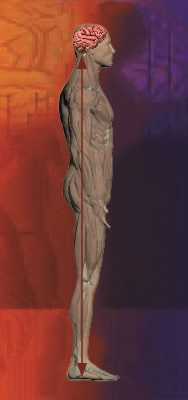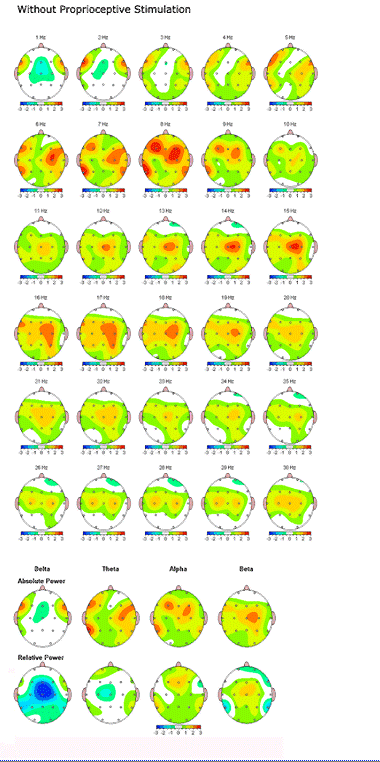Positive Health Online
Your Country

Alteration in Plantar Pressure Gradients (Foot Function) Linked to Alterations in Brain Wave Activity
by Brian A Rothbart PhD(more info)
listed in bodywork, originally published in issue 271 - June 2021
Alteration in Plantar Pressure Gradients (Foot Function) Linked to Alterations in Brain Wave Activity
by Brian A Rothbart DPM DNM PhD FACFO FACPM
Published at Researchgate.net 01/09/2021 DOI: 10.13140/RG.2.2.26657.43364
In 2002 I published a paper describing two previously unrecognized abnormal inherited foot structures (PreClinical Clubfoot and Primus Metatarsus Supinatus deformities) that alter the skeletal alignment (foot to jaw).
In 2009, I presented my theory, suggesting that alterations in plantar pressure gradients (foot function) automatically change brain function, which in turn, changes the skeletal alignment (global posture). I termed this theory the Foot to Brain Connection and it was based on the results of pressure plate (Rothbart 2005) postural (Rothbart and Esterbrook 1988) and gait analysis studies (Rothbart 2004).

Foot to Brain Connection (Rothbart and Penzabene 2009) summarized:
This theory proposes that a neurophysiological pathway exists between the bottom of the feet and the brain (cerebellum). That this pathway transmits information to the brain that, in large part, determines the posture of the body:
- The plantar surfaces of the feet are embedded with millions of fast acting Meissner (touch activated) corpuscles
- While standing or walking, at any given moment, certain areas of the feet are touching the ground
- The Meissner corpuscles in the areas of the feet touching the ground are activated, forming a pattern of stimulation (also referred to as a plantar pressure gradient).
- This pattern of stimulation sends a signal to the brain, which the cerebellum uses to determine the position of the body in space (e.g., its posture)
- Acting on these signals, the cerebellum makes continuous micro adjustments in the body’s posture to maintain upright stability.
- In certain abnormal foot structures, for example the Primus Metatarsus Supinatus and PreClinical Clubfoot deformities (Rothbart 2010), the Meissner’s corpuscles are excessively stimulated along the outside or inside of the heel and the inside of the ball of the foot. That is, the plantar pressure gradient is altered resulting in a distorted pattern of stimulation (Rothbart 2010).
- These distorted patterns of stimulation are transmitted to the brain, producing an alteration in brain wave activity.
- This altered brain wave activity results in a distorted posture.
Below I have presented the results of a 2018 Quantitative Electroencephalographic (qEEG) case study which substantiates the foot to brain connection. That is, an alteration in the plantar pressure gradient (foot function) does indeed change brain activity.
Protocol
Specific proprioceptive insoles are used to change the plantar pressure gradient.
NeXus-32 qEEG machine is used to measure neural (brain wave) activity.
A Shielded EEG cap with 19 channels (AG/AgCl electrodes) is used to capture brain wave activity.
The sample size is N=1, repeated twice (4 readings) to rule out data corruption
Procedure
A 63 year old female was selected who was diagnosed as having the PreClinical Clubfoot Deformity and fitted with appropriate proprioceptive insoles.
Base Line set of readings, no alteration of plantar pressure gradient
Using the NeXus-32 multimodal neurofeedback (qEEG) machine linked to my computer via a fiber USB interface, a 5 minute reading was taken with the patient sitting, knees bent at 90 degrees, feet without socks or shoes, pressed to the ground (reading B1) The reading was repeated to validate the consistency of the recording (reading B2) Both recordings were identical.
Second set of readings, plantar pressure gradient altered using proprioceptive insoles
Using the NeXus-32 multimodal neurofeedback (qEEG) machine linked to my computer via a fiber USB interface, a 5 minute reading was taken with the patient sitting, knees bent at 90 chelating degrees, feet without socks or shoes, placed on top of IARPT proprioceptive insoles and pressed to the ground (reading S1). The reading was repeated to validate the consistency of the recording (reading S2). Both recordings were identical
All 4 readings were taken within minutes of each other.
Extrapolation of Data
Using Nexus BioTrace+ software, the neural activity (referred to as a brain map) was obtained from each set of readings. These brain maps are a graphical representation of the electrical potential (activity) of a large number of neurons in the cortex’s pyramidal cells.
J Marques Teixeira MD, PhD, Clinical Director at Neurobios in Porto Portugal compared these brain maps and provided a report.
Findings
The Teixeira report is pictorially presented in below animated Figures: Without versus With Proprioceptive Stimulation. It shows dramatic alterations in neural (brain) activity when the plantar pressure gradient (foot function) is altered with proprioceptive insoles.

Animated Figure: Without Proprioceptive Stimulation and.with Proprioceptive Stimulation
(Key: reduction of red zones indicates a normalization of neural activity)
However, when the plantar pressure gradient was not altered, the neural (brain) activity remained constant. This was demonstrated when comparing readings B1vsB2 and S1vsS2.
Summary
This qEEG study provides graphic evidence that an alteration in the plantar pressure gradient (foot function) alters neural activity (brain wave function): a validation of the Foot to Brain Connection theory.
This study needs to be repeated, using a larger number subjects, before it can considered definitive. However, the results are compelling and a larger study is currently under development by the author.
Citations
- Rothbart BA, Esterbrook L, 1988. Excessive Pronation: A Major Biomechanical Determinant in the Development of Chondromalacia and Pelvic Lists. Journal Manipulative Physiologic Therapeutics 11(5): 373-379.
- Rothbart BA, 2002. Medial Column Foot Systems: An Innovative Tool for Improving Posture. Journal of Bodywork and Movement Therapies (6)1:37-46
- Rothbart BA 2004. Postural Distortions. The foot connection. Online Journal of Orthodontics, May 10; 6(1): 1-8
- Rothbart BA 2005. Tactile therapy shifts patients towards equilibrium. Biomechanics. Vol XII, No 10:61-68.
- Rothbart BA, Penzabene LF 2009. Forever Free From Chronic Pain. Chapter 5. The Foot to Brain Connection. Happy About Publishers, California USA.
- Rothbart BA 2010. The Primus Metatarsus Supinatus (Rothbarts) Foot and the PreClinical Clubfoot Deformity.Podiatry Review, Vol. 67(1):
- NeXus-32 Quantitative Electroencephalographic manufactured by Mind Media (https://www.mindmedia.com /en/ products/ nexus-32/
Acknowledgement Citation
Published at Researchgate.net 01/09/2021 DOI: 10.13140/RG.2.2.26657.43364
Comments:
-
No Article Comments available